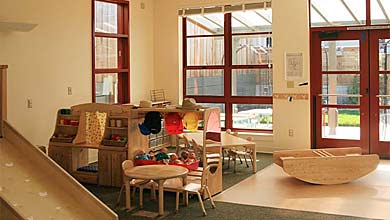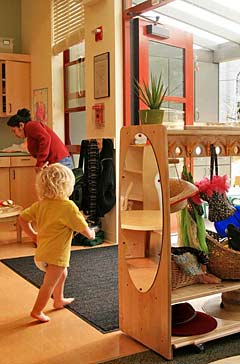UC Berkeley Press Release
 |
The Haste Street center is environmentally friendly, from its nontoxic pint-sized furniture to its "green" cleaning products. (Photos by Jonathan Martin/Capital Projects) |
High environmental certification for child care center
BERKELEY – Officials will gather today (Tuesday, April 29) to celebrate the University of California, Berkeley's first Leadership in Energy and Environmental Design (LEED)-silver certified building - the Haste Street Child Development Center - which also is the state's first freestanding LEED-silver certified child care center.
UC Berkeley's Haste Street Child Development Center is celebrating its certification by LEED (Leadership in Energy and Environmental Design), which has awarded the day care center a Silver rating for its design, construction and operation as a high-performance "green" building.
The U.S. Green Building Council's LEED Green Building rating system evaluates new and existing commercial, institutional and high-rise residential buildings according to their environmental attributes and sustainable features. To earn a silver rating, a building must score 33 to 38 points. The Haste Street center earned 38 points, one point short of the rare gold rating, said Chris Harvey, director of capital projects for UC Berkeley's Residential and Student Services Program.
The certification celebration is set for 4-5:30 p.m. today at the 2339 Haste St. facility.
The approximately $6 million center serves 78 infant, toddler and preschool offspring of UC Berkeley faculty, staff and students, and also provides facilities for education, social welfare and psychology researchers interested in child development.
"This center shows that our campus is serious about being socially responsible and responsive to the community," said Laura Keeley-Saldana, director of early childhood education in UC Berkeley's Residential and Student Service Programs.
 Kids and caretakers alike benefit from the new center's eco-friendly design and operation. |
The center is proving popular with parents looking for top-notch early childhood education and care as well as a healthy physical environment with food options that include organic fare from the campus dining facilities, said Keeley-Saldana. In addition, officials from child development centers at universities across the country have been contacting and visiting the Berkeley center to learn from its success, she said.
The high environmental standing of the Haste Street center, which opened in 2007, also appears to be a plus for recruiting and retaining teachers there, added Keeley-Saldana. She also noted that several local non-profit groups choose to hold their organizational meetings at the center not just because it is new and nearby, but because it's eco-friendly.
At the Haste Street center:
- Ninety-eight percent of the waste materials left over from construction were diverted from landfills and recycled. Its system of fluorescent lights, photocells for lighting circuits, radiant heat in concrete floors and on-demand water heater enable the facility to exceed California's mandated energy efficiency standards by 40 percent. Twenty percent of the center's materials came from within 500 miles of the site.
- No illumination leaves the site.
- Housekeeping supplies are free of toxic chemicals.
- Storm water runoff from the site was reduced by 25 percent compared to runoff from the site's previous use as a parking lot.
- Sensors monitor indoor carbon monoxide levels.
- Paints, sealants and other indoor materials were selected because of their minimal "off-gassing" of indoor air pollutants.
Some $60,000 in funding from Stopwaste.Org, an arm of Alameda County's Waste Management Authority and Source Reduction and Recycling Board, enabled UC Berkeley to hire a special consultant on LEED certification to help guide the center's progress from design to initial operation and to have an engineering firm commission the building's operating systems, Harvey said.
While the UC system has incorporated expectations for LEED equivalency into all of its major capital projects, it does not mandate that each project undergo a formal and often expensive certification process that can cost thousands of dollars.
Ironically, said Judy Chess, assistant director for green building programs at UC Berkeley, the percentage costs of formal LEED certification generally decrease with the increasing size of a project. "It's a function of design, not a function of size," she said.
UC Berkeley Capital Project Manager Sally McGarrahan oversaw the center's planning and construction. The architect was Jacobson Silverstein Winslow/Degenhardt, and Vila Construction of Richmond was the contractor.
McGarrahan said "the biggest lesson is that this (certification) has to be a priority from the beginning of the process and has to guide your design decisions throughout. If you start thinking about it after some fundamental site and system questions are already determined, it will be almost impossible to achieve enough credits."
Harvey predicted that offering green buildings "will only get easier over time because everyone in the marketplace gets better educated."
The campus's next LEED-silver certification will be at University Village in Albany, where 324 units of replacement student family housing will be completed in July. New student residences at Unit 1 on Durant Avenue and Unit 2 on Haste Street opened in 2005 and received recognition for LEED-silver equivalence.
More information about UC Berkeley's sustainability efforts is online at: http://sustainability.berkeley.edu/. The Green Building Research Center has been established on campus to promote sustainable building design at UC Berkeley and other California universities.

